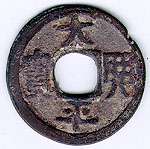Vietnamese đồng
The đồng (/dɒŋ/; Vietnamese: [ˀɗɜwŋ͡m˨˩]; sign: ₫ or informally đ; code: VND) has been the currency of Vietnam since May 3, 1978. It is issued by the State Bank of Vietnam. Formerly, it was subdivided into 10 hào, which were further subdivided into 10 xu, neither of which are now used. Since 2012 the use of coins has decreased greatly, and since 2014 coins are generally not accepted in retail, but will still be accepted in some, but not all, banks.
| Vietnamese đồng | |||||
|---|---|---|---|---|---|
| Đồng Việt Nam (in Vietnamese) | |||||
| |||||
| ISO 4217 | |||||
| Code | VND | ||||
| Denominations | |||||
| Subunit | |||||
| 1/10 | hào | ||||
| 1/100 | xu both subunits have been unused in Vietnam for several years | ||||
| Symbol | ₫/đ U+20AB ₫ DONG SIGN (HTML ₫) | ||||
| Banknotes | |||||
| Freq. used | 500₫, 1,000₫, 2,000₫, 5,000₫, 10,000₫, 20,000₫, 50,000₫, 100,000₫, 200,000₫, 500,000₫ | ||||
| Rarely used | 100₫, 200₫ | ||||
| Coins | |||||
| Rarely used | 200₫, 500₫, 1000₫, 2000₫, 5000₫ (no longer minted or in active use; still legal tender) | ||||
| Demographics | |||||
| User(s) | |||||
| Issuance | |||||
| Central bank | State Bank of Vietnam | ||||
| Website | www | ||||
| Valuation | |||||
| Inflation | |||||
Etymology
The word đồng is from the term đồng tiền ("money"), a loanword from the Chinese tóng qián (Traditional Chinese: 銅錢; Simplified Chinese: 铜钱). The term refers to Chinese bronze coins used as currency during the dynastic periods of China and Vietnam.
The term hào is a loanword from the Chinese háo (Chinese: 毫), meaning a tenth of a currency unit.
The term xu comes from French sous meaning "penny".
The sign is encoded U+20AB ₫ DONG SIGN (HTML ₫).
History
North Vietnam
In 1946, the Viet Minh government (later to become the government of North Vietnam) introduced its own currency, the đồng, to replace the French Indochinese piastre at par. Two revaluations followed, in 1951 and 1959; the first was at a rate of 100:1, the second at a rate of 1,000:1.
South Vietnam

Notes dually denominated in piastres and đồng were issued in 1953 for the State of Vietnam, which evolved into South Vietnam in 1954. On September 22, 1975, after the fall of Saigon, the currency in South Vietnam was changed to a "liberation đồng'' worth 500 old Southern đồng.
United Vietnam
After Vietnam was reunified, the đồng was also unified, on May 3, 1978. One new đồng equalled one Northern đồng or 0.8 Southern "liberation" đồng.
On September 14, 1985, the đồng was revalued, with the new đồng worth 10 old đồng. This started a cycle of chronic inflation that continued through much of the early 1990s.[2]
Coins
For the earlier modern Vietnamese coins, please see North Vietnamese đồng or South Vietnamese đồng.
First đồng
In 1978, aluminium coins (dated 1976), were introduced in denominations of 1, 2, and 5 hào and 1 đồng. The coins were minted by the Berlin mint in the German Democratic Republic and bear the state crest on the obverse and denomination on the reverse. Due to chronic inflation, these coins lost all their relevant value and no coins circulated for many years after this series.
Second đồng
Commemorative Issues
Commemorative coins in copper, brass, copper-nickel, silver, and gold have been issued since 1986, but none of these have ever been used in circulation.
2003 Issue
The State Bank of Vietnam resumed issuing coins on December 17, 2003.[3] The new coins, minted by the Mint of Finland, were in denominations of 200, 500, 1,000, 2,000, and 5,000 đồng in either nickel-clad steel or brass-clad steel. Prior to its reintroduction, Vietnamese consumers had to exchange banknotes for tokens with a clerk before purchasing goods from vending machines. This was also to help the state ease the cost of producing large quantities of small denomination banknotes, which tended to wear easily. Many residents expressed excitement at seeing coins reappear after many years, as well as concern for the limited usefulness of the 200 đồng coins due to ongoing inflationary pressures.[4]
Since the launch of the 2003 coin series, the State Bank has had some difficulties with making the acceptance of coins universal despite the partial discontinuation of smaller notes, to the point of some banks refusing coin cash deposits or the cashing in of large numbers of coins. This has prompted laws requiring private and municipal banks to transact and offer services for coins and the full discontinuation of small denomination and cotton-based notes.
| 2003 Series[3] | ||||||||||
|---|---|---|---|---|---|---|---|---|---|---|
| Image | Value | Technical parameters | Description | Date of | ||||||
| Diameter | Thickness | Mass | Composition | Edge | Obverse | Reverse | first minting | issue | ||
| [5][6] | 200₫ | 20 mm | 1.45 mm | 3.2 g | Nickel-plated steel | Plain | Coat of arms | Denomination | 2003 | December 17, 2003 |
 |
500₫ | 22 mm | 1.75 mm | 4.5 g | Nickel-plated steel | Segmented (3 groups) | April 1, 2004 | |||
| [7][8] | 1,000₫ | 19 mm | 1.95 mm | 3.8 g | Brass-plated steel | Reeded | Coat of arms | Water Temple, Đô Temple | 2003 | December 17, 2003 |
| [9][10] | 2,000₫ | 23.5 mm | 1.8 mm | 5.1 g | Brass-plated steel | Segmented (6 groups) | Highland Stilt house in Tay Nguyen | April 1, 2004 | ||
| 5,000₫ | 25.5 mm | 2.2 mm | 7.7 g | Brass (Cu92Al6Ni2) | Micro-scalloped | Một Cột Pagoda (One Pillar Pagoda) | December 17, 2003 | |||
| These images are to scale at 2.5 pixels per millimetre. For table standards, see the coin specification table. | ||||||||||
Banknotes
First đồng
In 1978, the State Bank of Vietnam (Ngân hàng Nhà nước Việt Nam) introduced notes in denominations of 5 hào, 1, 5, 10, 20, and 50 đồng dated 1976. In 1980, 2 and 10 đồng notes were added, followed by 30 and 100 đồng notes in 1981. These notes were discontinued in 1985 as they gradually lost value due to inflation and economic instability.
Second đồng
In 1985, notes were introduced in denominations of 5 hào, 1, 2, 5, 10, 20, 30, 50, 100, and 500 đồng. As inflation became endemic, these first banknotes were followed by 200, 1,000, 2,000, and 5,000 đồng notes in 1987, by 10,000 and 50,000 đồng notes in 1990, by a 20,000 đồng note in 1991, a 100,000 đồng note in 1994, a 500,000 đồng note in 2003, and a 200,000 đồng note in 2006. Banknotes with denominations of 5,000 đồng and under have been discontinued from production, but as of 2015 are still in wide circulation.[11]
Five banknote series have appeared. Except for the current series, dated 2003, all were confusing to the user, lacking unified themes and coordination in their designs. The first table below shows the latest banknotes, of 100 đồng or higher, prior to the current series. On June 7, 2007, the government ordered cessation of the issuance of the cotton 50,000 and 100,000₫ notes. They were taken out of circulation by September 1, 2007. State Bank of Vietnam 10,000 and 20,000₫ cotton notes are no longer in circulation as of January 1, 2013.[12]
| Second đồng[3] | |||||||
|---|---|---|---|---|---|---|---|
| Image | Value | Dimensions | Main Color | Description | Date of | ||
| Obverse | Reverse | printing | issue | ||||
| 100₫ | 120 × 60 mm | Green | Coat of Arms | Phổ Minh Temple | 1991 | May 2, 1991 | |
 |
200₫ | 130 × 65 mm | Orange | Ho Chi Minh | Agricultural production | 1987 | September 30, 1987 |
| 500₫ | 130 × 65 mm | Pink | Port Haiphong | 1988 | August 15, 1989 | ||
| 1,000₫ | 134 × 65 mm | Multicolor on lime background | Lumber productions | October 20, 1989 | |||
| 2,000₫ | 134 × 65 mm | Multicolor | Textile factory | ||||
| 5,000₫ | 134 × 65 mm | Blue | Trị An hydropower plant | 1991 | January 15, 1993 | ||
| 10,000₫ | 140 × 68 mm | Red | Hạ Long Bay | 1993 | October 15, 1994 | ||
| 20,000₫ | 140 × 68 mm | Blue | Canned food factory | 1991 | March 2, 1993 | ||
| 50,000₫ | 140 × 68 mm | Green | Nhà Rồng Port | 1994 | October 15, 1994 | ||
| 100,000₫ | 145 × 71 mm | Brown | Ho Chi Minh's ethnic house | September 1, 2000 | |||
In 2003 Vietnam began replacing its cotton banknotes with plastic polymer banknotes, claiming that this would reduce the cost of printing.[13] Many newspapers in the country criticized these changes, citing mistakes in printing and alleging that the son of the governor of the State Bank of Vietnam benefited from printing contracts.[13] The government clamped down on these criticisms by banning two newspapers from publishing for a month and considering other sanctions against other newspapers. Even though the 2003 series banknotes listed in the table below have now completely replaced the old notes of the same denominations, as of 2019 the cotton fiber banknotes of 200, 500, 1000, 2000 and 5,000 đồng still remain in wide circulation and are universally accepted.
| 2003 Polymer Series[3][14] | ||||||||
|---|---|---|---|---|---|---|---|---|
| Image | Value | Dimensions | Main Color | Description | Date of | |||
| Obverse | Reverse | Obverse | Reverse | printing | issue | |||
| 10,000₫ | 132 × 60 mm | Dark brown on greenish yellow | Ho Chi Minh | Offshore platform | The first two digits of the serial number give the last two digits of the year of issue. | August 30, 2006 | ||
| 20,000₫ | 136 × 65 mm | Blue | Covered bridge in Hội An | May 17, 2006 | ||||
| 50,000₫ | 140 × 65 mm | Pink | Huế | December 17, 2003 | ||||
| 100,000₫ | 144 × 65 mm | Yellowish green | Temple of Literature | September 1, 2004 | ||||
| 200,000₫ | 148 × 65 mm | Brownish-red | Hạ Long Bay | August 30, 2006 | ||||
| 500,000₫ | 152 × 65 mm | Cyan-Purple | Ho Chi Minh's birthplace in Kim Liên | December 17, 2003 | ||||
| These images are to scale at 0.7 pixel per millimetre. For table standards, see the banknote specification table. | ||||||||
A commemorative polymer 50-đồng banknote dedicated to the fiftieth anniversary of the State Bank of Vietnam was issued in 2001, but its face value is so tiny that it clearly was meant only for collectors. The note is available in three forms, by itself, in a presentation folder or in a presentation folder in an envelope. In 2016, a 100-đồng banknote was issued on cotton-based paper to commemorate the 65th anniversary of central banking.
Bearer's checks 1992–2002
To support the growing industrial need for large money transactions, the State Bank issued "Bearer's Checks" or "State Bank Settlement Checks" (Ngân Phiếu Thanh Toán) in denominations from 100,000 to 5,000,000 đồng.[15] To prevent counterfeiting, these notes had many degrees of protection, their designs were changed every five to six months, and they had expiration dates five or six months after the date of issue. The checks worked until the banking system was upgraded to handle electronic transfers of large amounts of đồng, making most large cash transactions unnecessary.
Other uses of đồng
In the Vietnamese language, "đồng" can be used as a generic term for any currency by adding the name of a country as a qualifier. This practice is more common for more esoteric units of currency.
In present-day Vietnam, when mentioning an amount of money, the currency can be (and usually is) omitted.
Exchange rate
| Current VND exchange rates | |
|---|---|
| From Google Finance: | AUD CAD CHF EUR GBP HKD JPY USD INR CNY |
| From Yahoo! Finance: | AUD CAD CHF EUR GBP HKD JPY USD INR CNY |
| From XE.com: | AUD CAD CHF EUR GBP HKD JPY USD INR CNY |
| From OANDA: | AUD CAD CHF EUR GBP HKD JPY USD INR CNY |
| From fxtop.com: | AUD CAD CHF EUR GBP HKD JPY USD INR CNY |
After the revaluation of the Zimbabwean dollar on 1 August 2006,[16] the đồng became the least valued currency unit for months. Around 21 March 2007, the revalued Zimbabwean dollar regained least valued currency status (in terms of black market exchange rate), and on 7 September 2007 in terms of official exchange rate. After the use of the Zimbabwean dollar ceased on 12 April 2009,[17] the đồng was the second least valued currency unit after the Iranian rial as of 28 November 2014. Since 19 June 2014, the Vietnamese dong has been devalued a total of five times in an effort to help spur exports and to ensure the stability of the currency.[18]
| Year | USD Exchange rate |
|---|---|
| 1960 | 97 |
| 1970 | 410 |
| 1980 | 2,050 |
| 1990 | 6,500 |
| 2000 | 14,428 |
| 2010 | 19,495 |
| 2020 | 23,173 |
(Sources: tradingeconomics.com, imf.org)
See also
References
- https://www.imf.org/en/Countries/VNM
- "LOC Country Study Vietnam". Lcweb2.loc.gov. Retrieved 2014-01-07.
- State Bank of Vietnam. "Technical characteristics of Vietnamese currency" (in Vietnamese). Archived from the original on 2006-07-22. Retrieved 2006-08-09.
- "Curious Vietnamese sneak a peek at no-tear notes, coins". 2003-12-19. Archived from the original on 2004-06-01.
- "collection/vncoins/vn-20003-o". art-hanoi.com. Retrieved 2014-04-03.
- "collection/vncoins/vn-20003-r". art-hanoi.com. Retrieved 2014-01-25.
- "collection/vncoins/vn-1k03-o". art-hanoi.com. Retrieved 2014-04-03.
- "collection/vncoins/vn-1k03-r". art-hanoi.com. Retrieved 2014-01-25.
- "collection/vncoins/vn-2k03-o". art-hanoi.com. Retrieved 2014-04-03.
- "collection/vncoins/vn-2k03-r". art-hanoi.com. Retrieved 2014-01-25.
- "500,000 Vietnamese Dong: The Story of a Historic Banknote". www.banknoteworld.com. Retrieved 2017-03-24.
- http://english.vovnews.vn/Home/Cotton-banknotes-to-go-out-of-circulation/20129/142580.vov. Missing or empty
|title=(help) - BBC (2006-10-21). "Vietnam censorship concern grows". BBC News.
- NGÂN HÀNG NHÀ NƯỚC VIỆT NAM THÔNG BÁO PHÁT HÀNH TIỀN MỚI VÀO LƯU THÔNG Archived September 27, 2006, at the Wayback Machine
- Ngan Phieu (Bearer's Checks) 1992-2002 Coins and banknotes of Vietnam and French Indochina
- "Zimbabwe money loses three zeros". BBC News. July 31, 2006.
- 12 April 2009 (12 April 2009). "Zimbabwe Suspends Use of Own Currency | News | English". Voanews.com. Archived from the original on June 29, 2011. Retrieved 7 January 2010.CS1 maint: unfit url (link)
- "Vietnamese Dong Devaluations 2014-2016". globalcurrencyreset.net. 2016-05-23. Retrieved 2016-05-23.
- Krause, Chester L.; Clifford Mishler (1991). Standard Catalog of World Coins: 1801–1991 (18th ed.). Krause Publications. ISBN 0873411501.
- Pick, Albert (1994). Standard Catalog of World Paper Money: General Issues. Colin R. Bruce II and Neil Shafer (editors) (7th ed.). Krause Publications. ISBN 0-87341-207-9.
External links
| Wikimedia Commons has media related to Money of Vietnam. |
| Preceded by: North Vietnamese đồng Location: North Vietnam Reason: currency unification Ratio: at par |
Currency of Vietnam 1978 – 1985 Note: banknotes are dated 1976 |
Succeeded by: Second đồng Reason: inflation Ratio: 1 second đồng = 10 first đồng |
| Preceded by: South Vietnamese liberation đồng Location: South Vietnam Reason: currency unification Ratio: 1 new đồng = 0.8 liberation đồng | ||
| Preceded by: Moneyless economy Reason: Vietnamese invasion of Cambodia Note: It is unclear whether the North, the South đồng, or nothing at all was used after the invasion in January 1980 and before the issuance of a united đồng in May |
Currency of Cambodia 1978 – 1980 Concurrent with: Thai baht and some other foreign currencies, to some extent |
Succeeded by: Cambodian riel Reason: reintroduction of a national currency Ratio: 1 riel = 3 đồng = 0.25 U.S. dollar = 1kg rice |
| Preceded by: First đồng Reason: inflation Ratio: 1 second đồng = 10 first đồng |
Currency of Vietnam 1985 – |
Succeeded by: Current |


_Art-Hanoi_02.jpg)
_02.jpg)

